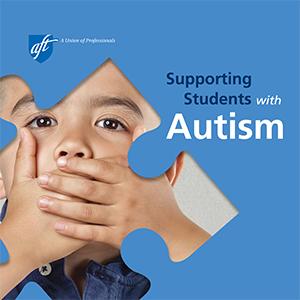According to the U.S. Department of Education, more than 655,000 children ages 3–21 attended school under the educational eligibility classification of autism in 2016–2017. And data from the Centers for Disease Control and Prevention show that as many as 1 in 68 children has an autism spectrum disorder (ASD). Given these statistics, most educators will work with ASD students at some point in their careers.
To receive an ASD diagnosis, individuals must show persistent deficits in social communication and social interactions and engage in repetitive patterns of behavior, interests, or activities. People with ASD have a wide range of abilities, with some needing substantial support throughout their lives. Below, we highlight key points from the AFT’s publication Supporting Students with Autism.
Effective Education for Students with Autism
When working with a student with autism, an effective educational program will capitalize on the student’s interests, offer a predictable schedule, teach tasks as a series of simple steps, actively engage the student’s attention in highly structured activities, and provide regular reinforcement of behavior.
Two of the core challenges for students with autism are communication and socialization, which can result in their responding to situations inappropriately. Behaviors may include loud vocalizations, leaving the instructional area, self-injury, aggression, or other inappropriate behaviors. With a high-quality, systematically implemented positive behavior support plan, students with autism can reduce inappropriate behavior and succeed in an educational environment.
To effectively address challenging behavior, the student’s educational team must understand why a behavior is occurring. A functional behavior assessment can help. It should include a clear description of the problem behavior(s); activities, times, and situations that predict when behaviors will and will not occur; consequences that maintain the problem behaviors; summary statements or hypotheses; and direct observation data to support the hypotheses.
Upon completion of a functional behavior assessment, a positive behavior support plan can be developed. It should include modifications in the environment that reduce the likelihood of the problem behavior, teaching plans for developing adaptive behaviors and replacement skills, natural and minimally intrusive consequences to promote positive behavior and deter problem behaviors, and a crisis plan (as needed). Specific training should be provided to all team members responsible for implementing the plan.
Building Relationships with Parents and Families
Collaboration between educators and families is crucial. A phone call or home visit prior to the start of the school year can help build the relationship, and so can honoring parents’ or family members’ extensive knowledge about the child. Throughout the year, be sure to communicate frequently with families about areas where students can improve, as well as areas where they have succeeded. Every parent wants to hear about his or her child’s accomplishments.
–AFT EDUCATIONAL ISSUES DEPARTMENT

